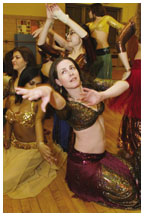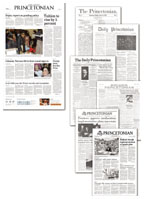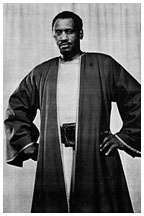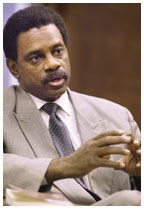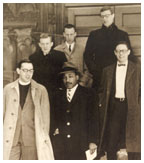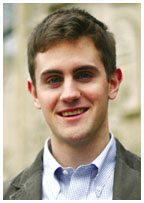Have an opinion about this issue of PAW? Please take a minute to click here and fill out our online questionnaire. It’s an easy way to let the editors know what you like and dislike, and how you think PAW might do better. |
February 23, 2005: Notebook
Tuition, room, and board to top $40,000 as trustees approve $950 million budget
Book on black history traces community-University ties
University asks judge to decide key points in Robertson lawsuit
Checkbook milestones First time Princeton tuition and fees exceeded: $10,000: $11,468 for 1982—83 $20,000: $20,498 for 1990—91 $30,000: $30,531 for 1998—99 $40,000: $40,213 for 2005—06 |
Tuition, room, and board to top $40,000 as trustees approve $950 million budget
In January, the Board of Trustees approved a $950 million operating budget for the 2005—06 academic year that includes a 5 percent increase in tuition, room, and board — the largest jump since 1993—94 — and new funding for health and well-being initiatives. The budget will improve support for compliance activities and recruitment and retention of faculty, staff, and students, University officials said.
Undergraduate tuition, room, and board will total $40,213 in 2005—06, with tuition set at $31,450, room at $4,610, and board at $4,153. Additional fees for residential colleges, student government, and class dues, which totaled $585 in 2004—05, have not yet been set. The budget, which is 4.6 percent larger than in 2004—05, includes additional funds for undergraduate financial aid to cover the higher tuition and fees. The rate of increase in the cost of a Princeton education had slowed for a decade before rising more rapidly in the last four years.
Provost Christopher Eisgruber ’83 and Vice Provost Katherine Rohrer *80 reported that it was “a challenging year to plan for the future” in a letter to President Tilghman from the Priorities Committee, a group of staff, faculty, and students that submits the budget to the trustees. Volatile energy costs were partly to blame for the University’s projected $5 million budget deficit in 2004-05, the committee said. A high vacancy rate in University housing, particularly graduate student housing, also accounted for $1.5 million of the shortfall, according to Steven Gill, the budget director and associate provost.
The University’s $9.9 billion endowment earned a 16.8 percent return in 2003—04, but the increase did not generate a notable change in the operating budget. Transfers from endowment income are set at a fixed percentage (5 percent per unit of endowment), established by the trustees to ensure a measure of consistency, regardless of market conditions.
Of the new budget’s $500,000 allocation for high-priority programs, about half will fund recommendations from the Task Force on Health and Well-Being, which outlined significant changes in the University’s health care programs in its final report, issued in November 2004. Psychiatric services, staffing, and increased summer coverage are among the needs addressed by the budget.
The University will spend more on its compliance with regulations such as tax laws, immigration requirements, and auditing standards by adding staff to the Office of the General Counsel and the Office of Internal Audit.
The budget also will finance more competitive stipends for graduate
students, particularly in the humanities and social sciences; new staff
at Career Services to coordinate internships; activities at the Lesbian,
Gay, Bisexual, and Transgender Center; and a small increase in the faculty
and staff salary pools, to address inflation and competition in the labor
market. The complete report of the Priorities Committee, outlining budget
recommendations and allocations, is available online at www.princeton.edu/~provost/priorities.
html. ![]()
By B.T.

Photo by Frank Wojciechowski
Marilyn Ham (front), a music department staff member, and other members
of Raks Odalisque, the University’s belly dance troupe, rehearse
for the group’s fifth annual spring dance concert March 3 to 5 at
Frist Campus Center. This year’s program showcases classical Indian,
Balkan Romany, traditional oriental, contemporary Egyptian pop, and eclectic
fusion dance styles. The dance troupe, which has 19 members, grew out
of belly dance classes taught through the Department of Athletics and
Recreation. ![]()

Above, the new color version of The Daily Princetonian is shown next to past designs, from top, 1876, 1899, 1914, 1943, 1969, and 2004. |
After more than a century as a tabloid, the Daily Princetonian has unfolded a new look. This semester, the student-run newspaper switched to a broadsheet format with full-color photographs on the front and back pages, one of the most distinct changes in the publication’s 128-year history.
When the paper debuted the new design in a trial run Dec. 1, editor-in-chief Zachary Goldfarb ’05 and the editorial board spread out across campus to hand-deliver copies to students departing for their morning classes. It did not take long to get feedback.
“This is awesome,” one student told Goldfarb. “It looks real now.”
It was not exactly the review Goldfarb expected, but the comment made sense. “It’s always been a tabloid that’s designed like a broadsheet,” Goldfarb said. “We tried to fit five or six stories on the front page.”
With more breathing room, the paper’s page designers can find space for bigger headlines, graphics, and photos. The result is “cleaner, colorful, and easy to read,” according to Goldfarb, who hopes the switch will help the paper improve and become one of the nation’s top student dailies. Half of the Ivy League student dailies have made the change to a broadsheet format, and all but two feature color photos.
The Prince upgraded to digital production in February 2004, paving the way for the switch to color printing, which Goldfarb said would have a minimal impact on production costs. The paper’s board of trustees weighed pros and cons of the new layout, cherishing the tradition and portability of a tabloid while recognizing the design potential of a larger, full-color canvas. “It was something that we thought about carefully,” said board member John Horan ’74, “and we thought, on balance, it was good for the paper.”
The Prince hired freelance designer Tito Bottita to give the pages their new look. Bottita, who had revamped the Daily Orange at Syracuse University, aimed for a refined presentation that would stand the test of time.
On average, the switch will drop about two pages from each issue of
the Prince. With large, bold feature stories on the front page,
Goldfarb said reporters and photographers are under some pressure to live
up to the layout. Melisa Gao ’06, who took the editorial reins from
Goldfarb in January, sees that pressure as positive. “Even before
we’ve taken over our roles, we’ve become this historic board
– the first full-color, broadsheet editorial board,” Gao said.
“It’s a huge opportunity.” ![]()
By B.T.

Photo by Brendan Smialowski/Getty Images
"Now, most of the media, because of the length of the war, is regaining the balance. Just after 9/11 the media was biased, and although it’s understood they would put American flags waving on screen, they stopped being journalists and got too close to the subject, and that is not good. ... The American media is now going back and not taking the government version of news to be the national one, and that’s good.”
Hafez Al-Mirazi, Washington bureau chief for Al-Jazeera television,
speaking about Mideast coverage by American media since Sept. 11, 2001.
The lecture was sponsored by the Princeton Middle East Society. ![]()

Photo: Princeton University Archives
An exhibition celebrating the 75th anniversary of McCarter Theatre will be on display in the main lobby of Firestone Library through Monday, May 2. Photographs, programs, and posters document the history of McCarter, from its origins in 1930 as a playhouse for the University's Triangle Club through its role today as an independent theater. Among the items are an autographed playbill from Othello starring Paul Robeson, above, and photographs of Dustin Hoffman in Three Men on a Horse and John Lithgow in Of Mice and Men. The exhibition will be open from 9 a.m. to 5 p.m. on weekdays (and until 8 p.m. on Wednesdays) and from noon to 5 p.m. on weekends.
“North Korea and the Bomb: How Real a Threat?” will be the subject of a panel discussion Thursday, March 3, at 4:30 p.m. in Dodds Auditorium in Robertson Hall. Panelists will be Bruce Cumings, professor of history, University of Chicago; Joseph R. De Trani, U.S. State Department special envoy to North Korea; and Gilbert F. Rozman, professor of sociology. The moderator will be Harold Feiveson, co-director of the Program on Science and Global Security and lecturer of public and international affairs. The panel is free and open to the public.
“More Perfect Than We Imagined: A Physicist’s View of Life” will be discussed on Saturday, March 5, by William Bialek, John Archibald Wheeler/Battelle Professor of Physics, as part of the Princeton Plasma Physics Laboratory’s “Science on Saturday” lecture series. The talks are geared toward high school students, but open to anyone. The laboratory is on the University's Forrestal Campus off Route 1 in Plainsboro. The free lectures begin at 9:30 a.m. and last about two hours. Registration is on-site prior to each session. Seating is first-come, first-served. For more information, go to www.pppl.gov or call (609) 243-2121.
Hans Blix, former U.N. weapons inspector and chairman of the international
Commission on Weapons of Mass Destruction, will speak on “Disarming
Iraq” at 7 p.m. on Tuesday, March 8, in Dodds Auditorium in Robertson
Hall. Princeton ID is required for admission to Dodds Auditorium. The
talk will be simulcast in Bowls 001, 002, and 016, which will be open
to the public, and available at www.wws.princeton.edu/
events/webmedia.html. ![]()

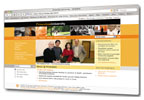 The
University’s redesigned Web site made its debut this month.
The
University’s redesigned Web site made its debut this month.
Princeton’s new Web site, redesigned by the communications office, went live in February with an updated look, added content, and a more powerful infrastructure. The site is the University’s most frequently viewed communication tool, attracting an average of 15,000 visitors per day.
The new site aims to expand on the information provided by Princeton’s previous Web pages, which displayed directory-style lists of links to University offices, departments, and programs. According to communications director Lauren Robinson-Brown ’85, the new pages will “tell the story of the campus” to both frequent users and newcomers, such as prospective students and parents. “A first-time visitor will be able to find a great deal about Princeton — what we stand for, what we do, and why this institution has meant so much to the world — by just clicking through the sections,” Robinson-Brown said.
Specific audience pages, directed at alumni, parents, students, prospective students, and faculty and staff, will help users navigate through the site by providing news and links customized for each group. Graphically, the new site incorporates photographs of campus life, architecture, and academic activities, framed in wide horizontal bands of orange, white, and black. “Visually speaking, we wanted something that is attractive and engaging, something with a sense of expansiveness,” said Reed Meister, the director of Web communications and strategic projects.
The Web site’s launch was four years in the making, stemming from
a Web strategy task force that first spotted the need for better accessibility,
navigation, and content management. The communications office initially
scheduled the release for the beginning of the fall 2004 semester, but
vetting the site’s expanded content proved time-consuming, pushing
the project back five months. ![]()
By B.T.

A chemical that causes some people to overeat also may play a role in
alcohol dependency, according to a study conducted by Princeton psychology
researchers. Past studies have shown that consuming fatty foods triggers
the brain to produce the protein galanin, which increases the desire for
more fat. When other chemicals fail to counteract the galanin, the appetite
for fat persists. Now, a team led by visiting research fellow Michael
Lewis and professor Bartley Hoebel says that galanin may have the same
effect on the thirst for alcohol. When researchers injected rats with
galanin, the rats drank more alcohol but maintained their food intake.
The study was published in the December 2004 issue of Alcoholism:
Clinical and Experimental Research. “Alcohol is the only drug
of abuse that is also a calorie-rich food,” Lewis said in a University
release, “and it undoubtedly has important interactions with systems
that control food intake and nutrition.” ![]()

Jack Washington (Frank Wojciechowski)
Martin Luther King Jr. with Assistant Dean of the Chapel Carl Reimers, to King’s right, and chapel deacons on the steps of Chancellor Green in 1960. (Princeton University Archives) |
Book on black history traces community-University ties
When Woodrow Wilson, Class of 1879, was inaugurated as the University’s president in 1902, delegates from colleges around the country came to Princeton. Booker T. Washington, president of the Tuskegee Institute, marched in the colors of Harvard University and Dartmouth College, from which he had received honorary degrees. But after the ceremony, the nation’s leading black scholar was not invited to dine with the other dignitaries or stay with a Princeton faculty member. He slept at a black boardinghouse in town. The episode, according to local historian Jack Washington, showed “there was still much work to be done” in Princeton’s race relations, and much would happen in the decades to come.
With support from a three-year fellowship from the University’s African-American studies program, Washington, a high school teacher in Trenton with a Ph.D. in history from Rutgers, researched two centuries of accounts about the black community in Princeton. His book, The Long Journey Home (Africa World Press), was released in October 2004.
The Princeton community and the University have been connected for most of their histories, Washington said, but one oft-repeated link is actually a myth. The idea that Princeton’s black residents descend from slaves of Southern undergraduates is not supported by Washington’s research, which found that both slaves and free blacks were a part of Princeton before the College of New Jersey came to town.
Washington also learned that blacks were part of the University’s educational history long before the first African-American undergraduates were admitted. In 1774, two free blacks, John Quaumino and Bristol Yamma, came to the college and trained to become missionaries, receiving instruction from then-President John Witherspoon. Two decades later, former slave John Chavis studied religion at Princeton before becoming a Presbyterian minister. Newspaper articles refer to blacks attending lectures during James McCosh’s time on campus, shortly after the Civil War, and Alexander Dumas Watkins became Princeton’s first black instructor in the late 19th century, tutoring students in histology.
Black history at the University also includes more recognizable names.
As early as 1910, W.E.B. DuBois campaigned for Princeton to admit black
students, and Martin Luther King Jr. and Malcolm X spoke on campus in
the 1960s. As Washington notes, Princeton lagged behind its Ivy peers
in admitting black undergraduates. But he said the University eventually
took a leadership role on matters of race, reflecting the values of its
hometown. “Princeton is better off for having the University in
Princeton,” said Washington, “and I think the University is
a better place because of the diversity of the community.” ![]()
By B.T.

Illustration: Steven Veach
The University will ban smoking in undergraduate dorms starting next fall, citing concerns about the effects of secondhand smoke and fire hazards.
“The work of the Undergraduate Life Committee [ULC] determined that a vast number of Princeton undergraduates strongly support smoke-free housing,” said Janet S. Dickerson, vice president for campus life, in announcing the new policy. “The ULC also noted its respect for individual rights to smoke but found this right did not outweigh the rights of others to be free of second-hand smoke.”
The ULC cited a report by the Harvard School of Public Health that students who live in smoke-free residence halls are 40 percent less likely to take up smoking than those who live in housing where smoking is permitted. In addition, a health survey last year showed that less than 17 percent of undergraduates smoke.
Currently, smoking is prohibited in common areas of Princeton’s
undergraduate dorms and residential colleges. Smoking is permitted in
residential rooms, but the rights of nonsmokers prevail over those of
smokers. Smoking is prohibited in classrooms and offices on campus. ![]()

A record 16,331 students applied for admission to Princeton’s Class
of 2009, a 19 percent increase from last year and about 600 more applicants
than the previous high, set two years ago. Dean of Admission Janet Rapelye
credited enhanced recruiting and Web-based application forms for the rise
in interest. This year’s applicants were the first to have the option
to apply to Princeton using the Common Application, a standardized form
used by more than 240 U.S. colleges. ![]()

University asks judge to decide key points in Robertson lawsuit
The University has asked a New Jersey Superior Court judge to rule on key legal issues raised by the Robertson family in the family’s lawsuit against Princeton.
In papers filed Feb. 2, Princeton asks that the court:
• Affirm that the University, and through it the Woodrow Wilson School of Public and International Affairs, is and will remain the sole beneficiary of the Robertson Foundation. The University is seeking a declaration that the foundation’s funds cannot be transferred to another institution.
• Uphold the decision of the foundation Board of Trustees to retain the Princeton University Investment Company (PRINCO) as the foundation’s investment manager.
• Permit the spending of capital gains and appreciation as income of the foundation, along with dividends and interest.
The late Charles Robertson ’26 and his wife, Marie, donated $35 million to set up the Robertson Foundation in 1961 to expand and support the graduate program of the Woodrow Wilson School. The fund is now worth an estimated $620 million. Robertson family members are suing Princeton for what they called the University’s “betrayal of the Robertson family’s trust” and for what the family views as a failure to fulfill the foundation’s mission of training government servants in international affairs.
In the new filing, the University accused the Robertson family of “attempting to hold the foundation and the Woodrow Wilson School hostage” and said statements by the family could negatively affect Wilson School grant applications and the pool of student applicants.
Robertson family lawyer Frank Cialone called the University filing “ill-advised”
and said it did not raise new issues. The case is scheduled for trial
in early 2006. ![]()

(Photo by John Jameson ’04) |
Princeton senior Kyle Jaros will receive the 2005 Daniel M. Sachs Class of 1960 Graduating Scholarship. The award, one of the highest honors given to Princeton undergraduates, will fund Jaros’ tuition and living expenses as he travels next year to Nanjing University to continue Chinese language study and to research the relationship between Chinese nationalism and China’s foreign policy in the early 20th century. Jaros, a native of Palo Alto, Calif., is a Woodrow Wilson School major who plans a career in international relations.
The University has hired Charles Davall, Princeton Borough’s former police chief, to serve as deputy director of operations in the Department of Public Safety. Davall, who stepped down as chief Jan. 31, is responsible for day-to-day operations and decreasing the University’s reliance on neighboring police departments for minor offenses. During his tenure as chief, borough police sparked controversy with an undercover operation at University eating clubs in which younger police officers were sent into the clubs seeking evidence of illegal drug use. No drug charges were filed, but underage drinking led to charges against four club officers. The charges ultimately were dropped after the clubs agreed to improve security and monitor drinking, and Davall said he felt relations between the police and the eating clubs have improved significantly since then.
Robert George, Princeton’s McCormick Professor of Jurisprudence,
has been named one of four recipients of the 2005 Bradley Prize for outstanding
achievement by the Lynde and Harry Bradley Foundation, a prominent conservative
group. The foundation praised George as “an influential thinker,
revered educator and a prolific author.” Each award carries a $250,000
prize. ![]()


